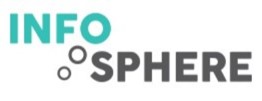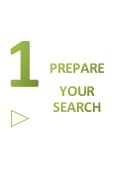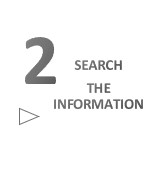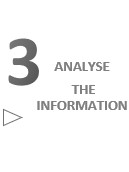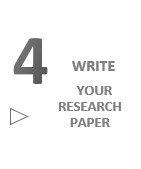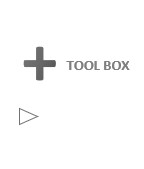Prepare your search
 Processing Request
Processing Request
Depending on the type of academic work required and the time allowed, it is recommended to assess the degree of depth that the literature search must reach.
 Objectives
Objectives
· Differentiate the types of work offered.
· Define the documentary needs, on the basis of this work.
· Judge the nature of the information needed.
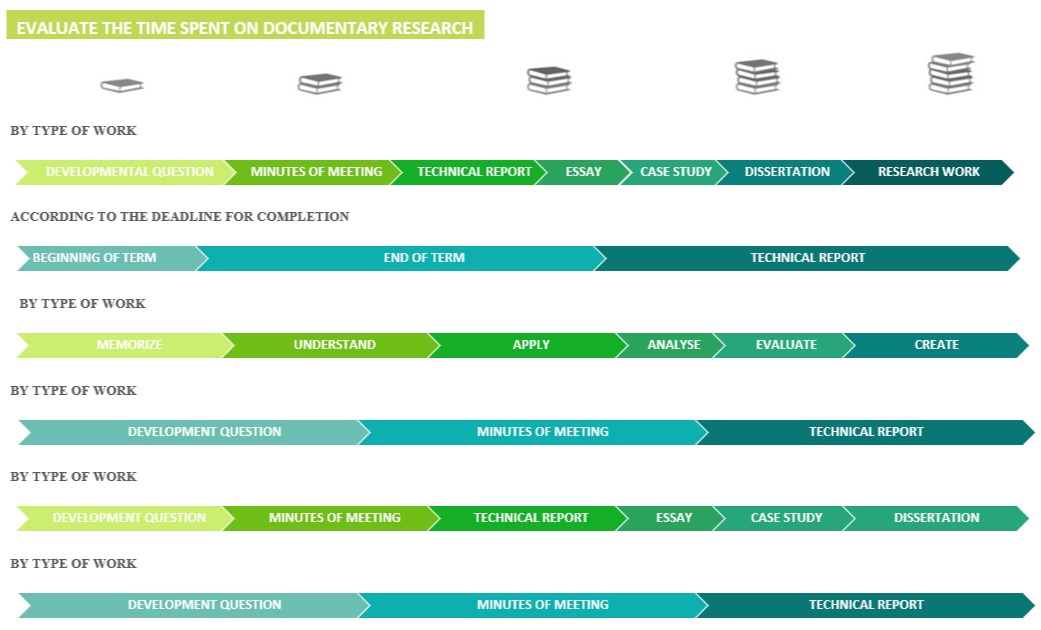
![]()
Development question
Exam to do in class, or homework, consisting of a few paragraphs or several pages.
Nature of information: Course notes, recommended texts, clarification of concepts (dictionaries, encyclopedias).
Review (informative or critical)
Description as faithful as possible of a reading, a fact, an event.
Nature of information: Author's book, other previously published reviews, documents allowing the work or author to be placed in their social and literary context (biographies, encyclopedias).
Technical report
A structured report in which facts or observations gathered during experiments, field trips, internships or investigations are reported.
Nature of information: General works on the discipline, encyclopedias, manuals / handbooks.
Test
Free text that allows you to express your opinions in a coherent and organized way without dealing with the subject exhaustively.
Nature of information: Variety of documents to feed his reflection.
Case Study
Systematic analysis of a situation in order to find solutions and solve a problem.
Nature of information: A variety of documents that relate the facts that help and provide a picture of the situation and study and make the correct diagnosis.
Dissertation (explanatory or argumentative)
Text that questions, doubts, brings a different or contrary vision, helps to clarify the pros or cons, the advantages and disadvantages (Variety of documents)
Nature of information: A variety of documents containing facts and ideas that describe, demonstrate, explain the subject or phenomenon.
Research work
Long text that usually involves developing a thesis and proposing arguments that support it. The goal is to discover new relationships between facts.
Nature of information: A variety of documents providing facts and ideas to define the problem and support its arguments.
![]()
To clearly differentiate between primary, secondary and tertiary sources of information, consult the page Categories of information sources Complement
Infosphère / https://infosphere.uqam.ca
Conducting more advanced research (usually at the graduate level) may require the creation of its own set of data. It is therefore important to develop good data management practices so that they can eventually be accessible, depending on their life cycle, to the entire scientific community.
 Objective
Objective
- Gain an overview of the tools, methods and sources of information involved in data collection and processing.
DATA HARVESTING
Data collection consists of collecting facts that will confirm or refute one's working hypotheses.
It involves:
- Specific tools
- Rigorous methods/procedures
- Miscellaneous sources of information
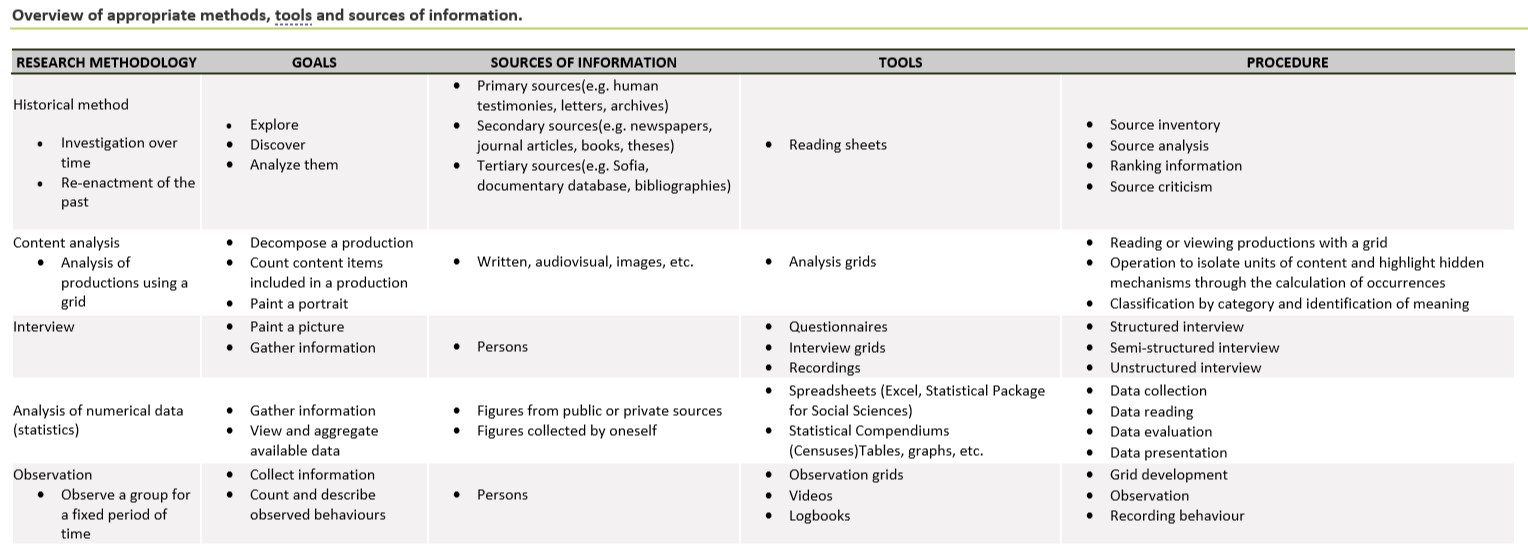
Table adapted from: Bernard Dionne, Pour réussir : guide méthodologique pour les études et la recherche, 6e éd., Montréal, Chenelière éducation, 2013, p.152-153.
![]()
- Consultation of information sources is always necessary, regardless of the method of data production or collection. In most cases, library staff can help you identify the most relevant sources of information to consult. Consult a librarian if needed!
![]()
- Find textbooks on the subject in the Koha search tool Example: Statistical methods applied to management
- Research Data Management Topic Guide
- Support Kit for Responsible Conduct in Research-Creation
Infosphère / https://infosphere.uqam.ca
Information receives varying degrees of processing from its extraction to update it to its analysis for easy identification. Sources of information are usually classified into three broad categories: primary, secondary, and tertiary.
 Objectives
Objectives
- Differentiate between broad categories of information sources.
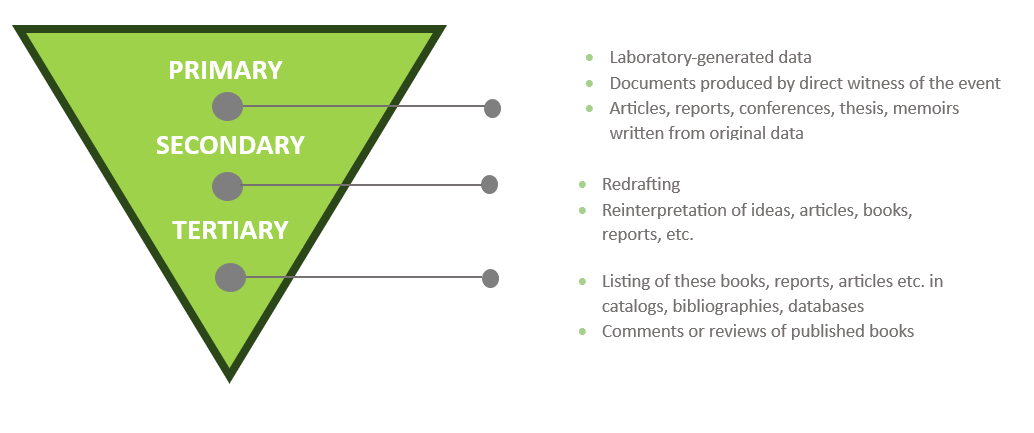
![]()
The classification of sources may vary according to the disciplines.
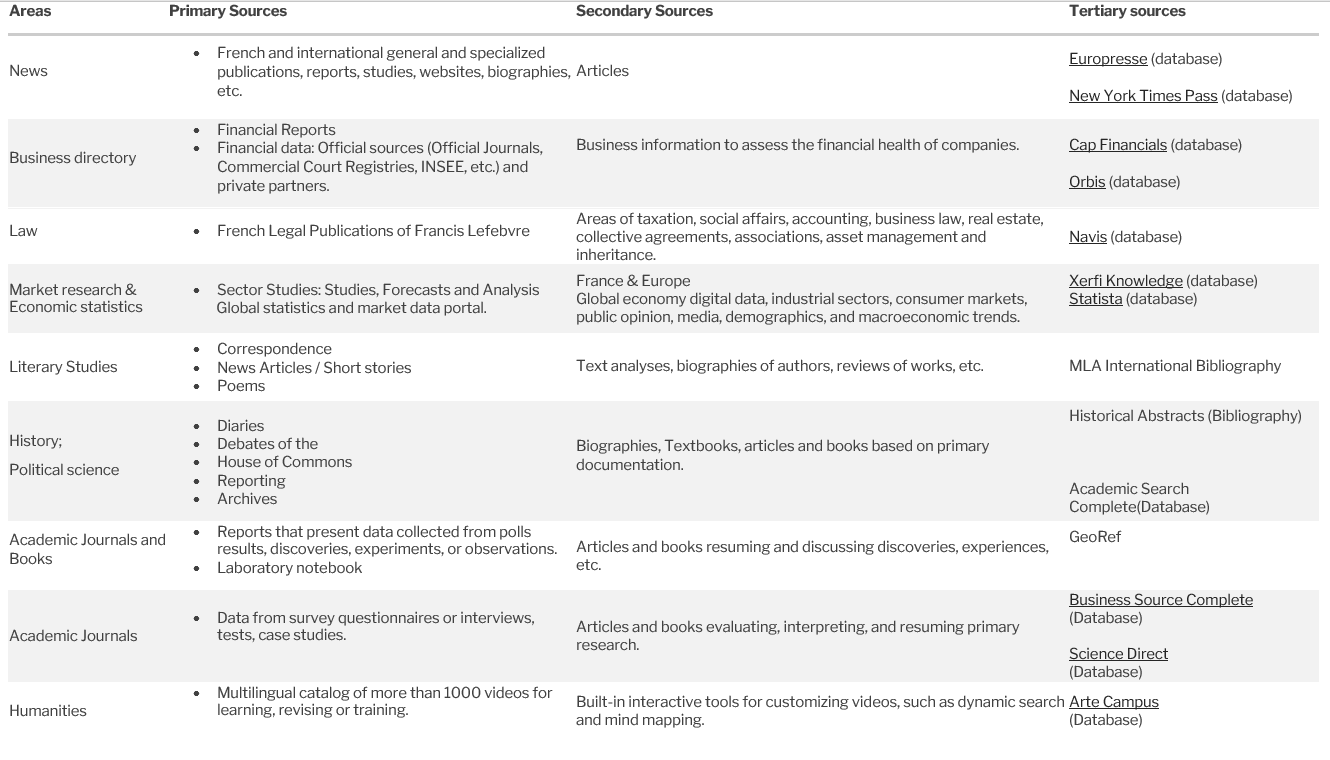
![]()
- The tertiary sources of information must be used to identify effectively all the literature classified under the secondary and primary categories.
Infosphère / https://infosphere.uqam.ca
Taking the time to clearly define your subject at the outset saves a lot when it comes to documentary research and note-taking. Several criteria must be considered when choosing your subject, not just your personal interest.
 Objective
Objective
-
Know the criteria for rationally choosing a research topic.
THE CHOICE OF SUBJECT
Various factors influence the choice of subject. Some are more personal, others are external like the time allocated and the documentation available.
Influencing factors

![]()
- By choosing your subject rationally, the work can easily be planned, thus saving time and avoiding mistakes.
Taking the time to clearly define your subject at the outset saves a lot when it comes to documentary research and note-taking. Several criteria must be considered when choosing your subject, not just your personal interest.
Infosphère / https://infosphere.uqam.ca
Being well organized is the key to delivering quality work on the required date.
 Objectives
Objectives
- Use a tool to plan the completion of your work.
SIMULATION OF A WORK CALENDAR
Session work
|
STAGE |
ACTIVITIES |
APPROXIMATE TIME |
IF YOU HAVE 15 WEEKS… |
|---|---|---|---|
|
1 Prep work |
Choice of topic |
20% |
3 weeks (~14h) |
|
2 Information work |
Reading |
40% |
6 weeks (~28h) |
|
3 Writing work |
Plan |
40% |
6 weeks (~28h) |
![]()
There are also mobile planning applications on the web:
- iStudiez Pro or Jorte calendar and why not try this tool from the Diapason website!
- You can also simply use a weekly planner like this:
 Worksheet Work Schedule.docx
Worksheet Work Schedule.docx
Infosphère / https://infosphere.uqam.ca 
The flow of information is something that must be taken into account when preparing research on a current topic. Here is an example:
The Lac-Mégantic rail accident occurred on July 6, 2013 at 1:14 a.m.
An event occurs. Following this event, documents are created at different times to report the facts, analyze it and make an assessment of it. The resulting information over time may then be factual, subjective, technical or scientific.
A few minutes later...
At 1:58 a.m., the event was reported on Twitter and picked up the following hours elsewhere by the web, possibly on radio and TV.
|
Public |
Type of info |
Author |
Length |
Content |
Point of view |
Where to find? |
|---|---|---|---|---|---|---|
|
All audiences |
Descriptive |
Citizens and journalists |
50 to 2000 words |
Brief, instantaneous, fast |
Informative |
The following days:
The week following the Lac-Mégantic accident, 152 articles appeared in La Presse alone.
Ex.: Meunier, H. (2013, July 8). 6000 Méganticois, 6000 dramas. La Presse, p. A3
|
Public |
Type of info |
Author |
Length |
Content |
Point of view |
Where to find? |
|---|---|---|---|---|---|---|
|
All audiences |
Descriptive |
Journalists, some specialists |
50 to 2000 words |
Graphics, analysis, photo, opinion |
Somewhat neutral |
Log index. Ex: Eureka |
The following weeks:
Articles appear in popular periodicals of general interest.
E.g. Longchamps, R. (2013). Upper Hearts Lac-Mégantic, Tuesday, July 23, 2013. White Night, (132), 24-25.
|
Public |
Type of info |
Author |
Length |
Content |
Point of view |
Where to find? |
|---|---|---|---|---|---|---|
|
All audiences |
Current affairs, popular topics |
Journalists, writers |
250 to 5000 words |
Report, discussion, photo, opinion |
May be subjective: editorial |
Index of periodicals. Ex: Benchmark |
The following months:
Articles appear in academic and scholarly journals as well as reports. Conferences can be held on the subject.
Ex. : Champkin, J. (2013). A carriage full of curates. Significance, 10(5), 30-31.
Transportation Safety Board of Canada (TSB). (2013, March 11). TSB Engineering Laboratory Report. (LP148/2013). Gatineau: TSB.
|
Public |
Type of info |
Author |
Length |
Content |
Point of view |
Where to find? |
|---|---|---|---|---|---|---|
|
Researchers, specialists and students |
Search results, reflections |
Subject matter specialists |
2,500 to 10,000 words |
Detailed study, statistical analysis, graphs, bibliographic references |
Objective, neutral. Technical language |
Index of periodicals. Ex: Scopus |
Two years later...
Conference proceedings having been published in previous years, books and theses dealing with the subject appeared in the following years.
E.g. Beaupré, E. (2013). Lac-Mégantic: the images of tragedy, a story of unfailing solidarity. Montreal: Character.
|
Public |
Type of info |
Author |
Length |
Content |
Point of view |
Where to find? |
|---|---|---|---|---|---|---|
|
All audiences |
Analysis |
Subject matter specialists |
150 pages or more |
From general discussion to detailed analysis |
That of the author |
Research tools. Ex: Sofia |
Ten years later...
Knowledge and understanding of the event or topic is established. It is referred to in reference works such as encyclopedias.
E.g.: Wikipedia flags an article...
|
Public |
Type of info |
Author |
Length |
Content |
Point of view |
Where to find? |
|---|---|---|---|---|---|---|
|
All audiences |
Facts, overview |
Subject matter specialists |
1 to 10 pages |
State of knowledge |
Current point of view, objective |
Research tools. Ex: Sofia |
Infosphère / https://infosphere.uqam.ca
THE CYCLE OF SCIENTIFIC INFORMATION PRODUCTION
 RESEARCH IDEA
RESEARCH IDEA
Information not published at this stage.
- Definition of the problem and hypotheses
- Review of the writings produced
- Reflections on the idea
- Production of research data (e.g. laboratory notes)
![]() To access this information, you need to know the creator of it.
To access this information, you need to know the creator of it.
![]() INFORMAL COMMUNICATIONS
INFORMAL COMMUNICATIONS
Information not published at this stage.
- Discussion of the first results or conclusions with colleagues interested in the topic.
![]() To access this information, you must be part of this invisible college or try to integrate into this professional network.
To access this information, you must be part of this invisible college or try to integrate into this professional network.
![]() UNPUBLISHED LECTURES
UNPUBLISHED LECTURES
Information sometimes publicly available at this stage.
- Oral presentation only of research and initial findings at conferences in order to gather feedback from the scientific community.
![]() To access this information, you must attend the conference.
To access this information, you must attend the conference.
Sometimes speakers self-publish their manuscript on the Web. These documents do not yet have a "scientific" status since they are not validated by the scientific community.
![]() RESEARCH REPORTS
RESEARCH REPORTS
Information published outside the major distribution channels.
- This is called grey literature. It consists of preprints, reports, dissertations and theses.
![]() Information often available in institutional repositories or from organizations.
Information often available in institutional repositories or from organizations.
![]() ARTICLES
ARTICLES
Information published by an editor in conference proceedings or in peer-reviewed or non-peer-reviewed journals.
- Research results are deemed worthy enough to be presented to the scientific community.
![]() To access this information, you have to subscribe to the journals or get the records yourself if you have a lot of money) or through libraries.
To access this information, you have to subscribe to the journals or get the records yourself if you have a lot of money) or through libraries.
The open access movement makes a small portion of these publications freely available. Many search results fail to achieve this publication status.
![]() DOCUMENTARY DATABASES
DOCUMENTARY DATABASES
Information product developed by a publisher that lists articles.
- These products therefore allow the identification of articles although sometimes the full text may be there. Some databases are free like PubMed and ERIC but otherwise they are usually paid.
![]() To consult them, you pay a subscription yourself (if you have a lot of money) or you use the library.
To consult them, you pay a subscription yourself (if you have a lot of money) or you use the library.
If the search results are published in a secondary journal, the content of that review may not be reported in the searched database.
![]() BOOKS
BOOKS
Product published by a publisher.
- The scientific research that has become well established in articles ends up being described in books.
![]() You can buy the books or use the ones from the library.
You can buy the books or use the ones from the library.
The majority of search results will never be mentioned in books.
![]() REFERENCE WORKS
REFERENCE WORKS
Product published by a publisher.
- Standard vocabulary, best practices, state-of-the-art and major scientific consensus on a subject are condensed from articles and books into textbooks, handbooks and encyclopedias.
![]() You can buy the (often expensive) reference books or use the ones from the library.
You can buy the (often expensive) reference books or use the ones from the library.
A minority of research results will be large enough to be retrieved from reference works.
Infosphère / https://infosphere.uqam.ca
Once you have chosen your research topic, it is useful to identify it and specify the purpose of the work to be done in order to establish a strategy that will make it possible to find the right documents.
 Objectives
Objectives
- Adopt an effective strategy to clearly identify a research topic.
- Define the purpose of the academic work to be done.
DELINEATE YOUR SUBJECT
In order to properly define the topic, it is necessary to examine it from several angles by asking questions about the priority aspects to be studied, the groups of individuals concerned, the importance of the geographical context or the period of time to be considered. Then, we summarize all these elements in one sentence of a few lines:
- Use meaningful, precise words.
- If possible, formulate the sentence as a question.
EXAMPLE
What is the role and impact of labour market integration programs among young Quebec university graduates over the past 5 years?
This summary sentence will later be useful in establishing a search strategy in documentary databases.
IDENTIFY YOUR SUBJECT
![]() Worksheet Defining your topic.docx
Worksheet Defining your topic.docx
In the form below, answer the questions according to the chosen topic. Refer to the example as necessary to clarify the meaning of the question.
General theme of work
General theme of work
What?
What are the aspects that interest me? What are the components of the question?
What answer
Who?
Which specific groups are affected by the issue?
Who answers
When?
What is the time period? Is it a specific time? Can it be circumscribed in time?
When to reply
Where?
What is the geographical context? Can we limit it to a particular region? Country?
Where answer
Comment?
What approaches or points of view should be considered? Historical? Sociological? Economical? Statistics? Legal? Scientist? Ethics?
How to respond
What for?
What is the meaning or importance of the topic? What are the implications? Why should we care?
Why answer
What questions would I like to answer?
Questions and answers
PURPOSE OF THE WORK
The choice of methodology and the selection of documents depend on the purpose of the work.
Some examples of links between purpose and methodology
|
Purpose of the work |
Possible methodology |
|---|---|
|
Inform, present facts |
Review of writings (Historical method) |
|
Tracing the evolution of an idea or a school of thought |
Review of writings (Historical method) |
|
Analyze a situation, an event |
Content analysis Interview Data analysis |
|
Test a hypothesis |
Data analysis Observation |
|
Propose a solution to a problem |
Case Study |
![]()
- By clarifying the purpose of the work and clearly identifying the topic, it is easier to establish an effective research strategy.
![]() Links / Documents
Links / Documents
- For examples of information sources based on methodology, see the data collection table.
Infosphère / https://infosphere.uqam.ca
Depending on the need for information, it is important to choose the appropriate type of document and identify the most effective search tool to locate this document.
The professor often provides a list of documents to be consulted. By reading these references, it is possible to identify the type of document in question. It is then easier to take the appropriate actions to obtain and consult it.
 Objectives
Objectives
- Know the main types of documents and their usefulness.
- Identify the most effective search tools according to the type of document desired.
THE DIFFERENT TYPES OF DOCUMENTS
- A commentary with its informative value;
- An example of a reference;
- The most effective tool(s) to spot it.
Informative value
Proceedings are the collection of papers presented at congresses, symposia or scholarly meetings, by researchers or specialists. Each paper, often confused with a journal article, contains a detailed summary of the presentation made by one or more researchers.
This type of document addresses the latest research findings on very specific topics. This content often precedes that published in articles.
What is the most effective tool to spot them?
Informative value
Archives are the preferred sources for documenting the past.
Whether personal, administrative, financial or technical, they are essential materials for history. They can also provide information on the causes of an event or a present situation (e.g. old construction or development plans).
What is the most effective tool to spot them?
![]() BNF (National Library of France)
BNF (National Library of France)
Informative value
It provides factual, political and statistical information on local, national and international current events.
Topics are often treated from an informative rather than analytical point of view.
Newspaper articles update data, present various facts, provide information on the latest political, cultural or scientific developments, for example, and provide timely information that may be more difficult to find in other sources of information, as is the case, for example, with certain statistical information.
What is the most effective tool to spot them?
Informative value
Journal articles offer specific information, with a variable level of analysis but usually deeper than a journal article. Its content is often more current than in books.
To distinguish the types of journals, consult the Journals in Review table in the Analyze Information module.
What is the most effective tool to spot them?
Informative value
A patent is a legal document issued by governments for new products or processes with industrial applications.
The patent provides access to technical and strategic information not found in scholarly journals.
What is the most effective tool to spot them?
![]() Espacenet Patent Search
Espacenet Patent Search
This type of document helps to visualize the reality of a territory. The multiple forms of representation help to understand and situate the phenomena of physical geography as well as social, political, economic, etc. phenomena.
These may include topographical, geological, climatic, ecoforestry maps, plans (land use or other), aerial photographs, etc.
Reference books to consult at the beginning of the research because they provide factual information.
Encyclopedias contain articles that take stock of major topics (general or specialized) and are usually written by specialists. .
For an overview of dictionary types with suggestions for good dictionaries, see the Useful Resources page of the Writing Your Work module of Infosphere.
What is the most effective tool to spot them?
These documents of historical and artistic value are not only a source of testimony to document a work, but are also the object of analysis at the cinematographic level.
What is the most effective tool to spot them?
![]() Library
Library
This type of information makes it possible to describe qualitatively and quantitatively a current situation. In addition to statistical data, financial, marketing and geospatial data can also be used.
What is the most effective tool to spot them?
Informative value
The images, illustrations, photos, engravings, etc. bring a dynamism to the text that favors its reading. Its visual elements can sometimes better express concepts that are much more difficult to translate into words or can document an event. Finally, images and other visual productions are also the object of analysis in arts disciplines.
What is the most effective tool to spot them?
We consult the books to take stock of our subject, find arguments and support the ideas we want to formulate.
In general, books deal with a subject in some depth and often refer to well-known people, events, research, past or contemporary facts. However, some books such as novels, stories, short stories, etc. are the subject of literary analysis or criticism.
Sometimes only part of a book is retained for work. The reference is then made only to this part. This is commonly the case with book chapters.
In the field of education, books are designed for didactic purposes and are given the name "Textbooks". Among the manuals, there are "handbooks" that give quick and convenient access to basic information and the state of the art of certain practices in specific disciplinary areas. They contain, for example, factual information, statistics, graphs, tables, equivalencies or procedures.
What is the most effective tool to spot them?
Legal collections present the legal aspect of a fact, situation or event. They are varied in nature: laws, regulations, conventions, jurisprudence, treaties.
What is the most effective tool to spot them?
Standards rarely have the force of law, but the precepts they contain enshrine best practices in a professional field. For example, standards may describe important features of a product, service or system. They are intended, among other things, to ensure a certain uniformity for trade between nations that do not necessarily have the same regulations.
What is the most effective tool to spot them?
A preprint presents content equivalent to that of scientific articles but whose peer review is not completed. This allows research results to be communicated more quickly to speed up access to new research results and stimulate the work of other experts in the field. It is then important to validate afterwards that the peer review confirms the results of the prepublication.
What is the most effective tool to spot them?
Government and international publications (IMP) consist mainly of official documents of ministries and public agencies. It contains a variety of documents ranging from simple brochures to a wide variety of reports. The most common reports are commission reports, technical and scientific reports, and annual reports.
Other legal entities produce annual reports and scientific and technical reports such as non-governmental organizations (NGOs), companies, associations or pressure groups.
Technical or research reports often contain up-to-date information that will not be found anywhere else. They study a well-defined reality in time, synthesize the opinions expressed and propose recommendations, following specific mandates, often governmental or international organizations.
Annual reports provide a portrait and balance sheet of an organization or business for a given year. They provide information on the management and finances of companies and provide information on the strategic directions of companies or organizations.
What is the most effective tool to spot them?
![]() Government sources
Government sources
![]() International Organizations
International Organizations
Tests are instruments for measuring or evaluating subjects. In the context of UQAM, they are particularly used in research concerning education, vocational development, psychology and sexology.
According to Rénald Legendre's Dictionnaire actuel de l'éducation (3rd edition of 2005, p.1375), there are two main categories of tests:
- tests related to teaching disciplines such as diagnostic, ranking, performance, proficiency tests
- tests related to general development such as tests of aptitude, intellectual functioning, personality, attitudes, social functioning, interests, physical worth factors (PPF)
What is the most effective tool to spot them?
These research reports are specifically written in the context of university graduate studies and present the authors' findings.
These documents contain unpublished information that brings together most of the literature on a problem and exposes the different points of view of the author's reflection.
What is the most effective tool to spot them?
 Bear in mind
Bear in mind
- Google is not always the most effective search tool. It really depends on the type of document you are looking for.
![]()
- By knowing how to distinguish the types of documents, it is easier to identify those that will be useful for the realization of a particular research work.
![]()
- Use the worksheet
 feuille_de_travail the characteristics of the documentation to use.docx to use to identify its needs.
feuille_de_travail the characteristics of the documentation to use.docx to use to identify its needs. - National Library of France (BNF)
- France archives
- Publications Office of the European Union
Infosphère / https://infosphere.uqam.ca
By specifying the types of documents to be explored, it will be easier to identify the search tools to be used. The form below can be used to record the characteristics of the documentation potentially useful for carrying out an academic work.
![]() feuille_de_travail characteristics of the documentation to be used.docx
feuille_de_travail characteristics of the documentation to be used.docx
Period
![]() Of:
Of:
Month
Day
Year
![]() At:
At:
Month
Day
Year
Places
Places
Tongue
Tongue
Domain
domain
Type d'information
t_information_o1
Topicality
Historical
Theoretical
Statistics
t_information_o2
Statistics
Scientist
Technic
Popularization
Type of documents
t_documents_o1
Colloquium proceedings
Archives
Newspaper articles
Journal articles
Patents
Documentaries / films
Data
Dictionaries / Encyclopedias
Cards
Images / photos
t_documents_o2
Books / Handbooks
Acts and Regulations
Standards
Preprints
Government publication
Commerce
Statistics
Tests
Theses / dissertations
Other
Titles already known
titres_connus
Web Site
Web sites
Research tools
Tools search
Infosphère / https://infosphere.uqam.ca 
.png)
